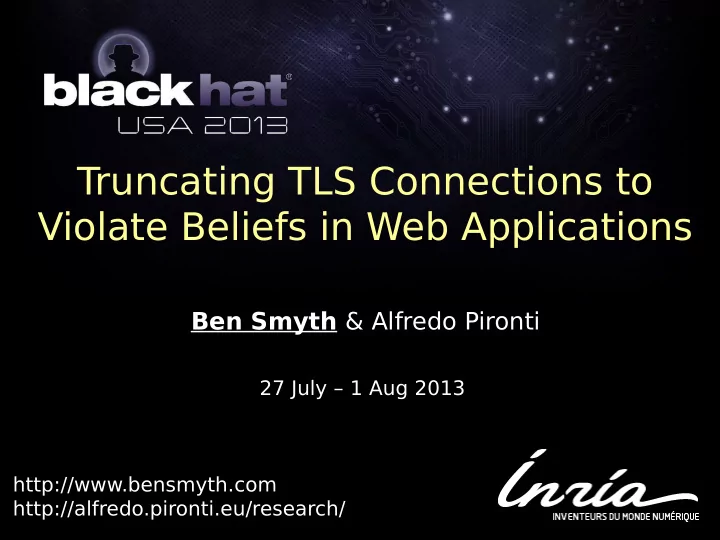

Truncating TLS Connections to Violate Beliefs in Web Applications Ben Smyth & Alfredo Pironti 27 July – 1 Aug 2013 http://www.bensmyth.com http://alfredo.pironti.eu/research/
Contribution Attacks which truncate TLS connections to exploit logical web application flaws, enabling: Cast votes [on behalf of honest voters] in Helios elections ● Full control of Microsoft Live accounts ● Temporary access to Google accounts ● We suspect our insights will lead to the discovery of further attacks.
TLS security Application Security: Server (and client) authentication ● Confidentiality ● Crypto TLS Integrity: messages received as sent ● – Single connection TCP Termination modes: Graceful closure ● – all messages received as sent Te Termination mod odes Termination modes Fatal closure (e.g., after a corrupt message) ● ignored ignored – a prefix of messages received as sent
Truncating TLS connections “ failure to properly close a connection no longer requires that a session not be resumed [...] to conform with widespread implementation practice ” – TLS specification Consider a wire transfer to “ Charlie's Angels” : POST /wire_transfer.php HTTP/1.1 Host: mybank.com Content-Type: application/x-www-form- urlencoded Content-Length: 40 amount=1000&recipient=Charlie%27s_Angels Suppose the request is fragmented by TLS 1)POST […] recipient=Charlie 2)%27s_Angels Attack: Drop the 2 nd fragment to transfer money to Charlie.
Truncating TLS connections “ failure to properly close a connection no longer requires that a session not be resumed [...] to conform with widespread implementation practice ” – TLS specification Consider a wire transfer to “ Charlie's Angels” : Server ignores: termination mode ● POST /wire_transfer.php HTTP/1.1 Host: mybank.com Content-Length field ● Content-Type: application/x-www-form- urlencoded Fix: Content-Length: 40 wire transfers upon ● amount=1000&recipient=Charlie%27s_Angels graceful closure only Suppose the request is fragmented by TLS check lengths ● 1)POST […] recipient=Charlie 2)%27s_Angels Attack works against Apache Attack: Drop the 2 nd fragment to transfer money to Charlie. Henceforth, we consider truncation attacks which drop messages, rather than fragments
Challenges for web applications Web applications: Browsers maintain multiple ● connections (to load content in parallel, for example) TLS provides: No integrity gaurantees ● across multiple connections – hence, ordering issues between connections
Challenges for web applications Web applications: Browsers maintain multiple ● connections (to load content in parallel, for example) TLS provides: Adversary model (standard): ● Adversary has full control of No integrity gaurantees ● the network across multiple connections – hence, ordering issues – i.e., read, delete, and between connections inject messages
Helios electronic voting system A cryptographically verifiable electronic voting system Verifiability enables us to use untrusted DREs and check afterwards that the claimed result is valid
Helios: Ballot casting 1) REQUESTS https://vote.heliosvoting.org/helios/elections/<<id>>/cast_done Response: 200 - OK; HTML payload: … <p><b>For your safety, we have logged you out.</b></p> <iframe border="0" src="/auth/logout" frameborder="0" height="0" width="0"> </iframe> … 2) REQUESTS https://vote.heliosvoting.org/auth/logout Response: 302 - Moved Temporarily Location[http://vote.heliosvoting.org/] Notification of sign-out before DRE makes the request! 3) Truncate sign-out request 4) Use the DRE to cast a new vote No TLS protection: sign-out request (2) and adversary (4) use different connections. However, attack is detected, because Helios is verifiable. Fix: (1) & (2) atomic. A video demonstrating this attack will be available online.
Microsoft Live accounts Setting: Shared computer (e.g., public library, work place, …) ● – Trusted computer, i.e., not tampered with – Adversary accesses computer after honest user has finished Video Demo (Live demos are too stressful!) The video will be available online.
Microsoft Live accounts Setting: Shared computer (e.g., public library, work place, …) ● – Trusted computer, i.e., not tampered with – Adversary accesses computer after honest user has finished Notification of sign-out before server receives request (client's belief ≠ server's belief)! Truncate sign-out ● Access account on another connection ● Fixes: Centralise authentication; or ● Chain sign-out requests ● The video will be available online.
Google accounts Setting: Shared computer (e.g., public library, work place, …) 1)GET https://accounts.google.com/Logout?continue=https://www.google.com/webhp Response: 302 - Moved Temporarily, Location[http://www.google.com/accounts/Logout2? ilo=1&ils=mail,s.FR&ilc=0&continue=https://www.google.com/webhp?zx=1388193849] 2)GET http://www.google.com/accounts/Logout2?ilo=1&ils=mail,s.FR&ilc=0 &continue=https://www.google.com/webhp?zx=1388193849 Response: 200 - OK; HTML payload: <body onload="doRedirect() "> <script type="text/javascript"> function doRedirect() { location.replace("http://www.google.fr/accounts/Logout2?ilo=1&ils=s.FR& ilc=1&continue=https://www.google.com/webhp?zx=1076119961"); } </script> <img width="0" height="0" alt="Sign Out" src="https://mail.google.com/mail?logout=img&zx=-2531125006460954395"> </body> 3)GET https://mail.google.com/mail?logout=img&zx=-2531125006460954395 Response: 200 - OK; a one pixel gif. 4)...
Google accounts: Attack <body onload="doRedirect() "> <script type="text/javascript"> function doRedirect() { location.replace("http://www.google.fr/accounts/Logout2?ilo=1&ils=s.FR& ilc=1&continue=https://www.google.com/webhp?zx=1076119961"); } </script> <img width="0" height="0" alt="Sign Out" src="https://mail.google.com/mail?logout=img&zx=-2531125006460954395"> </body> Notification of sign-out before server receives request! Truncate Gmail sign-out with TCP reset ● – (TCP drop hangs the browser) Fatal connection closure ignored ● Access Gmail on another connection ● – House-keeping terminates (~5mins) Fixes: Handle fatal connection closure; or ● Centralise auth. or chain sign-outs ● A video demonstrating this attack will be available online.
Summary We exploit flaws in sign-out procedures to prevent termination of ● sessions, whilst notifying the user of success. – Attacks against Helios, Google & Microsoft Consequently, even trusted shared computers offer no security! ● Fixes proposed, therefore trusted shared computers offer security. ● All vulnerabilities have been disclosed; ● but none have been fixed. Further attacks? (Vendors, let's discuss your products; Hackers, ● let's discuss their products.)
Questions? Tariff Industry: beer* ● Academics: citations ● Journalists: compliments ● * Exceptions might be made for future clients/employers... http://www.bensmyth.com http://alfredo.pironti.eu/research/
Recommend
More recommend